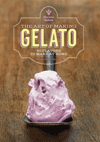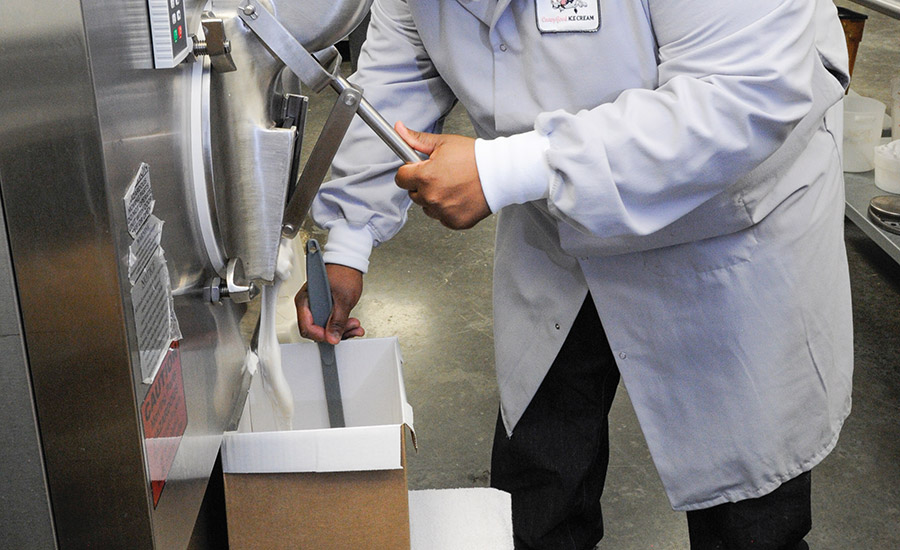Comfy Cow premium ice cream sees success and growth
When Whole Foods said it wanted to carry pints of The Comfy Cow’s super-premium ice cream, the founders invested in a bigger plant and additional equipment. A growing franchise operation also is creating demand.

Ice cream flows from a batch freezer into a foodservice-size carton. Inclusions and sauces are added by hand at another work station.

Head chef Erica Parker and Gary L. Steele hold the grand champion award for ice cream in the 2015 World Dairy Expo Dairy Product Contest. Parker’s winning recipe was Brown Butter Peanut Brittle.

In The Comfy Cow commissary, chefs make brownies, cookies, candy inclusions, brown butter and other ingredients to add to ice cream and cakes.

New processing and production equipment had just arrived when Dairy Foods visited The Comfy Cow production facility in February. A continuous freezer will give the creamery an output of 100 gallons an hour, significantly more than the capacity of the two existing batch freezers.




The Comfy Cow moved its ice cream processing operation from the back room of a scoop shop into a building in a Louisville, Ky., industrial park, the reaction from employees was: “This is huge! It’s like the Taj Mahal of ice cream making,” said co-founder Tim Koons-McGee.
Keep in mind that the new plant is small compared to the likes of a Nestle or Unilever facility. At 6,500 square feet, the plant includes a kitchen that bakes inclusions and makes sauces. But to The Comfy Cow, this is the engine that will supply ice cream to more than 300 grocers and 11 company-owned and franchised scoop shops this year. The long-range plan is for The Comfy Cow to be a national brand in packaged ice cream with scoop shops throughout the Southeast. (See related article)
When that happens, The Comfy Cow is going to need a larger plant. Until then, it is making ice cream and ingredients as efficiently as it can under the watchful eye of Gary L. Steele, vice president and director of production. Steele is a food production veteran and no stranger to challenges. He set up pizza kitchens throughout Eastern Europe and the Middle East for Papa Johns, another Louisville-based food business.
In 2015, The Comfy Cow invested a reported $2 million in the building it’s leasing in the Regency Pointe Business Center in Louisville’s Jeffersontown neighborhood. Over the next 10 years, the project is expected to create 40 to 50 new jobs. Currently there are 14 employees. The Kentucky Economic Development Finance Authority approved tax incentives up to $350,000.
Room to grow
Comfy Cow CEO Don Berg said the plant was designed so that it can be expanded modularly as the company adds new accounts. Based upon the business plan, it should be able to accommodate growth for the next five years. The investment was necessary because The Comfy Cow hit a growth spurt. Until then, the ice cream company was chugging along just fine making ice cream in batch freezers in the back room of one of its four company-owned stores.
The cause of the accelerated growth was Whole Foods, which expressed interest in carrying pints of the all-natural super-premium product. That’s when co-founders Tim and Roy Koons-McGee, who started the company in 2009, realized they needed help. They hired Berg (also known as the “Head of the Herd”), a former executive with the wine and spirits company Brown-Forman. Berg then brought on Steele.
Earlier this year, Steele showed Dairy Foods through the plant. A continuous freezer had just arrived but was not yet online. It will be able to fill 100 gallons an hour (an increase of 64 gallons). Pasteurized milk will flow into twin 600-liter tanks to cool and then into flavor vats. Then the mix will flow to the freezer, where Steele will be installing a new fruit feeder on this line.
On our visit, we saw single- and double-batch freezers producing ice cream. These will remain in use and supplement the production from the continuous freezer. The single-batch machine can make 17 gallons and the large one can make 36 gallons. Other recent equipment purchases include a homogenizer, storage tanks and freezer monitoring.
Pasteurized milk and cream arrive in 5-gallon bags once a week from dairy processor Prairie Farms. The milk is re-pasteurized for 35 minutes at 165 F. Then flavors are added and the mix is poured by hand into the batch freezers. When the ice cream is ready, a team of two fills 3-gallon foodservice-size paper containers by hand, adding sauces and inclusions according to the recipe. A paper cover is placed on top of the ice cream, then the lid.
The containers are carried to a blast freezer next to the production room where they remain for eight to 12 hours. Freezer trucks pull up to one of the two bays. They are loaded with ice cream to be delivered to customers. The Comfy Cow will be buying a new truck, Steele said.
The hand-filling of the 3-gallon containers and pints (in distinctive brick-style paper cartons) is reminiscent of processes done by The Ice Cream Club (see Dairy Foods, May 2014) and Grater’s (August 2011).
Baking inclusions
The Comfy Cow makes its own inclusions. In the kitchen, bakers prepare brownies, blondies, pecan pies, salted caramel, fruit toppings, brown butter and bourbon balls (a popular local confection dating to the 1930s). After coming out of the oven, the baked inclusions are cooled and then chopped to size. If not used in that day’s production, the inclusions are bagged and stored until needed. The bakery has four employees. It is adding a second shift to keep up with the demand from retail and franchise customers.
Head chef Erica Parker has developed more than 120 ice cream recipes. The company uses about 40 at any one time. The company has “quite a few bourbon flavors that are very popular,” Koons-McGee said. “Probably one of our most popular is the bourbon malt” made with Old Forester, a local product.
Parker, a graduate of Sullivan University’s hospitality program, is always thinking of new ideas. The company sent her to an ice cream program at the University of Wisconsin, Madison. Koons-McGee called Parker “amazing, incredibly talented and creative.” Her Brown Butter Peanut Brittle recipe was named the grand champion in the 2015 World Dairy Expo Dairy Product Contest, sponsored by the Wisconsin Dairy Products Association.
“She’s just got such a palate and such a creative sense of where the next new flavor is coming,” Koons-McGee said. “She’s always out there tinkering. The other day she brought in four or five samples of three new flavors, and we gave our opinion.”
A new flavor uses togarashi, a peppery Japanese spice mix. She developed a beer ice cream called the Tipsy Cow and a white chocolate/curry combination. Parker said she’s trying to develop an ice cream based on one of her favorite foods: sushi. She has not yet worked out the details.
When Berg accepted the award in Madison, judges told him “Who would have ever thought to put bourbon in ice cream?” He said his reaction was, “You have obviously never been to Kentucky. We put bourbon in everything down here.”
“Sometimes the only complaint we ever hear is there is not enough bourbon in our bourbon,” said Tim Koons-McGee.
Buying local
The Comfy Cow positions itself as a processor of super-premium ice cream made with local ingredients, which is important “for all the right reasons that everybody else tries to do it,” Koons-McGee said. That includes cutting down on the carbon footprint and supporting local economies.
“The local economy here has supported us. Plus, (local ingredients) just taste better,” he said. “Our peach ice cream usually comes out after everybody else’s because they are getting their peaches out of the South. Up here our peaches don’t become ripe until later.”
There are also financial incentives for buying local ingredients. The Comfy Cow participates in Kentucky Proud, a state marketing program for agricultural products. Members receive a rebate on advertising dollars and on Kentucky products, like milk. The Comfy Cow buys its milk through the Udderly Kentucky program, which guarantees that milk comes from 100% Kentucky cows.
“We are really proud to be the only ice cream maker that is actually using Udderly Kentucky, which is 100% small farms in Kentucky. It makes an impact on those farmers,” Koons-McGee said.
Food safety and testing
Berg has made food safety and quality a priority. In the manufacturing areas, employees clean and sanitize after every shift. Swab testing is done on Wednesdays and sent to a third-party lab to test for pathogens. Results arrive on Friday. There are foot baths at the entrance to the processing areas; a foaming system is planned. Steele is gearing up for food safety certification this summer. He is applying for BRC certification through the Global Food Safety Initiative.
Plant employees conduct daily sampling checks on all production. They pull product off the line and review the overrun, flavor, color, texture and inclusion/swirl rate. Steele will be adding a quality assurance lab to test for components (like butterfat) and to test packaging.
Since it is a small business, The Comfy Cow relies on state programs as well as guidance from industry peers. Koons-McGee said he found people working in the ice cream industry to be very open and helpful with their advice. Tim and Roy visited various ice cream shops in the southeast. Before they churned their first batch, they attended the National Ice Cream Retailers Association Convention.
“Those people were so generous with their time. They assigned you a mentor at the convention when you sign up. It was a great experience. We left there saying, ‘Let’s try this, we have the support,’” Tim said.
Tom Kelman of Kelman Consulting, Marshall, Wis., was also helpful to the Koons-McGees in starting their company. (“He’s remarkable,” Tim said.)
Nearly nine years later, Koons-McGee vividly remembers the help he received when starting up the business.
“You could just pick up the phone and call somebody. And they would be so open and free with their advice. It was invaluable, it really was. So we try to do the same thing whenever we can. We have been helped so much.”
One question remains to be answered. Will The Comfy Cow retire as ice cream grand champion or will it defend its title at the 2016 World Dairy Expo Dairy Product Contest? Berg hadn’t decided. The company has no shortage of innovative flavor ideas to enter. But there is something to retiring with a perfect 1-0 record.
Regardless, Tim and Roy Koons-McGee and Berg are enjoying what they are doing. The challenges are great, but the rewards are worth the hard work. Berg, the former Brown-Forman executive, has found his niche.
“Bourbon’s a fun business,” he said “Ice cream is a fun business. I often joke if my goal was to find something that people love more than bourbon, I found it. It’s a great product just to be associated with. That makes it fun, too.”
Looking for a reprint of this article?
From high-res PDFs to custom plaques, order your copy today!













